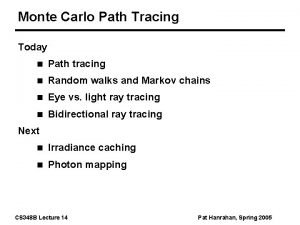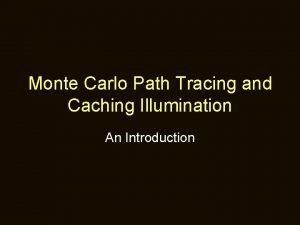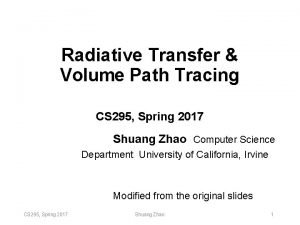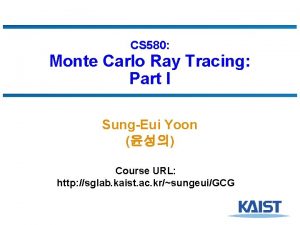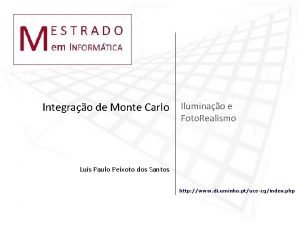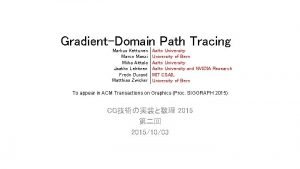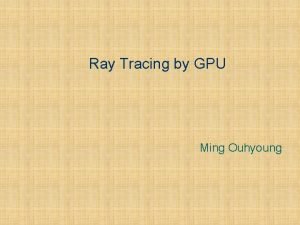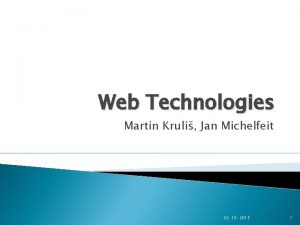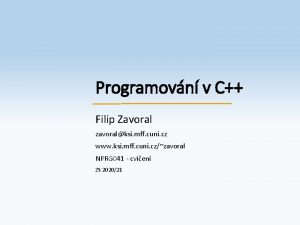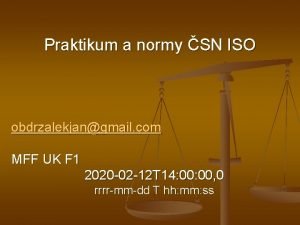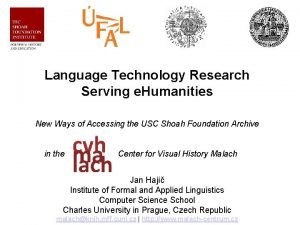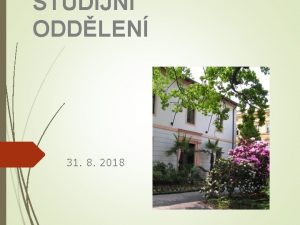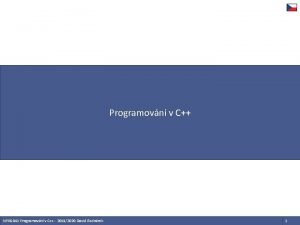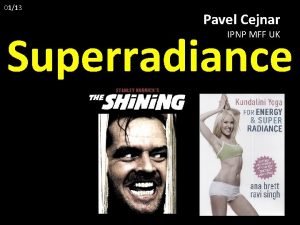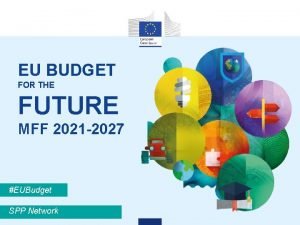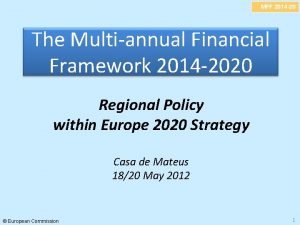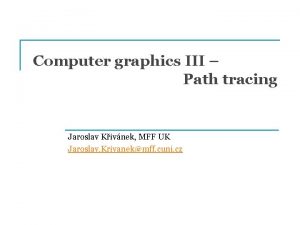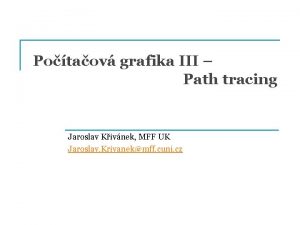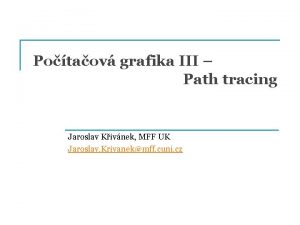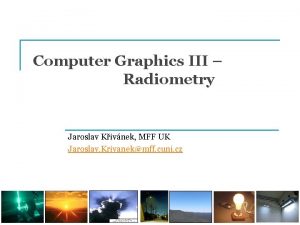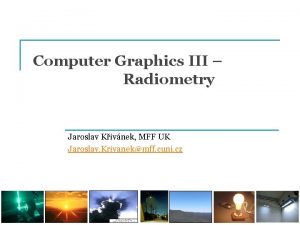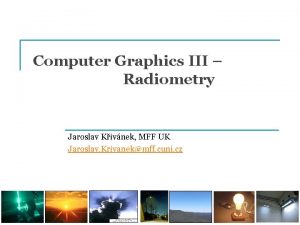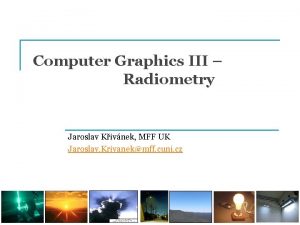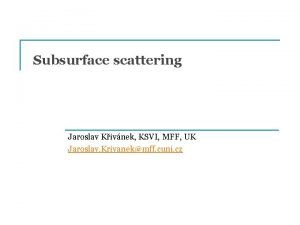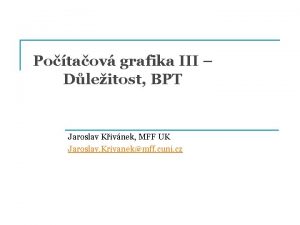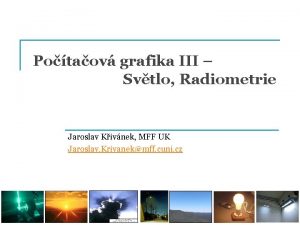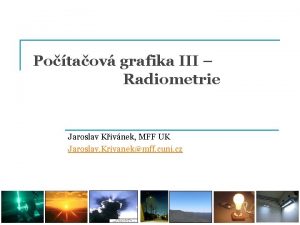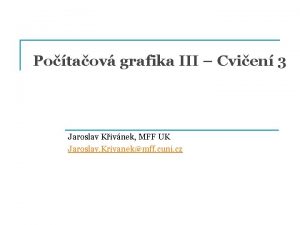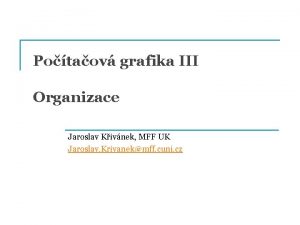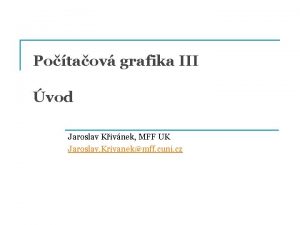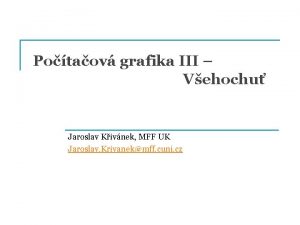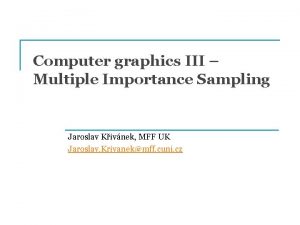Computer graphics III Path tracing Jaroslav Kivnek MFF




















- Slides: 20

Computer graphics III – Path tracing Jaroslav Křivánek, MFF UK Jaroslav. Krivanek@mff. cuni. cz

Tracing paths from the camera render. Image() { for all pixels { Color pixel. Color = (0, 0, 0); for k = 1 to N { wk : = random direction through the pixel. Color += get. Li(cam. Pos, wk) } pixel. Color /= N; write. Pixel(pixel. Color); } } CG III (NPGR 010) - J. Křivánek

Path tracing, v. 0. 1 (recursive form) get. Li (x, ω): y = nearest. Intersect (x, ω) return get. Le(y, –ω) + get. Lr (y, –ω) // emitted radiance // reflected radiance get. Lr(x, ωinc): [ωgen, pdfgen] = gen. Rnd. Dir. Brdf. Is(ωinc, normal(x) ) return 1/pdfgen * get. Li(x, ωgen) * brdf(x, ωinc, ωgen) * dot(normal(x), ωgen) CG III (NPGR 010) - J. Křivánek

Path Tracing – Loop version get. Li(x, wo) { Spectrum throughput = (1, 1, 1) Spectrum accum = (0, 0, 0) while(1) { hit = nearest. Intersect(x, wo) if no intersection return accum + throughput * bg. Radiance(x, wo) if is. On. Light. Source(hit) accum += thrput * get. Le(hit. pos, -wo) [wi, pdf(wi)] : = Sample. Dir(hit) Spectrum tput. Update = 1/pdf(wi) * fr(hit. pos, wi, -wo) * dot(hit. n, wi) survival. Prob = min(1, tput. Update. max. Component) if rand() < survival. Prob // russian roulette – survive (reflect) thrput *= tput. Update / survival. Prob x : = hit. pos wo : = wi else // terminate path break; } return accum; } CG III (NPGR 010) - J. Křivánek

Path termination – Russian roulette get. Li(x, wo) { Spectrum throughput = (1, 1, 1) Spectrum accum = (0, 0, 0) while(1) { hit = nearest. Intersect(x, wo) if no intersection return accum + throughput * bg. Radiance(x, wo) if is. On. Light. Source(hit) accum += thrput * get. Le(hit. pos, -wo) [wi, pdf(wi)] : = Sample. Dir(hit) Spectrum tput. Update = 1/pdf(wi) * fr(hit. pos, wi, -wo) * dot(hit. n, wi) survival. Prob = min(1, tput. Update. max. Component) if rand() < survival. Prob // russian roulette – survive (reflect) thrput *= tput. Update / survival. Prob x : = hit. pos wo : = wi else // terminate path break; } return accum; } CG III (NPGR 010) - J. Křivánek

Terminating paths – Russian roulette n Continue the path with probability q n Multiply weight (throughput) of surviving paths by 1 / q n RR is unbiased! CG III (NPGR 010) - J. Křivánek

Survival probability – How to set it? n It makes sense to use the surface reflectivity r as the survival probability q n If the surface reflects only 30% of energy, we continue with the probability of 30%. That’s in line with what happens in reality. What if we cannot calculate r? Then there’s a convenient alternative, which in fact works even better: 1. 2. First sample a random direction wi according to p(wi) Use the sampled wi it to calculate the survival probability as CG III (NPGR 010) - J. Křivánek

Adjoint-drive RR and splitting Vorba and Křivánek. Adjoint-Driven Russian Roulette and Splitting in Light Transport Simulation. ACM SIGGRAPH 2016 CG III (NPGR 010) - J. Křivánek

Direction sampling get. Li(x, wo) { Spectrum throughput = (1, 1, 1) Spectrum accum = (0, 0, 0) while(1) { hit = nearest. Intersect(x, wo) if no intersection return accum + throughput * bg. Radiance(x, wo) if is. On. Light. Source(hit) accum += thrput * get. Le(hit. pos, -wo) [wi, pdf(wi)] : = Sample. Dir(hit) Spectrum tput. Update = 1/pdf(wi) * fr(hit. pos, wi, -wo) * dot(hit. n, wi) survival. Prob = min(1, tput. Update. max. Component) if rand() < survival. Prob // russian roulette – survive (reflect) thrput *= tput. Update / survival. Prob x : = hit. pos wo : = wi else // terminate path break; } return accum; } CG III (NPGR 010) - J. Křivánek

Direction sampling n We usually sample the direction wi from a pdf similar to fr(wi, wo) cos qi q Ideally, we would want to sample proportionally to the integrand itself Li(wi) fr(wi, wo) cos qi, but this is difficult, because we do not know Li upfront. With some precomputation, it is possible to use a rough estimate of Li for sampling [Jensen 95, Vorba et al. 2014], cf. “guiding”. CG III (NPGR 010) - J. Křivánek

BRDF importance sampling n Let’s see what happens when the pdf is exactly proportional to fr(wi, wo) cos qi ? n Normalization (recall that a pdf must integrate to 1) The normalization factor is nothing but the reflectance r CG III (NPGR 010) - J. Křivánek

BRDF IS in a path tracer n Throughput update for a general pdf. . . thrput *= fr(. ) * dot(. ) / ( ρ * p(wi) ) n A pdf that is exactly proportional to BRDF * cos keeps the throughput constant because the different terms cancel out!. . . thrput *= 1 q Physicists and nuclear engineers call this the “analog” simulation, because this is how real particles behave. CG III (NPGR 010) - J. Křivánek

Path guiding Vorba, Karlík, Šik, Ritschel, and Křivánek. On-line Learning of Parametric Mixture Models for Light Transport Simulation. ACM SIGGRAPH 2014 CG III (NPGR 010) - J. Křivánek

Path guiding Vorba, Karlík, Šik, Ritschel, and Křivánek. On-line Learning of Parametric Mixture Models for Light Transport Simulation. ACM SIGGRAPH 2014 CG III (NPGR 010) - J. Křivánek

Direct illumination calculation in a path tracer

Direct illumination: Two strategies n At each path vertex x, we are calculating direct illumination q n i. e. radiance reflected from a point x on a surface exclusively due to the light coming directly from the sources Two sampling strategies 1. 2. BRDF-proportional sampling Light source area sampling Image: Alexander Wilkie CG III (NPGR 010) - J. Křivánek

The use of MIS in a path tracer n For each path vertex: q q Generate an explicit shadow ray for the techniques pb (light source area sampling – a. k. a. “next event estimation”) Secondary ray for technique pa (BRDF sampling) n n One ray can be shared for the calculation of both direct and indirect illumination But the MIS weight is – of course – applied only on the direct term (indirect illumination is added unweighted because there is no second technique to calculate it) CG III (NPGR 010) - J. Křivánek

Dealing with multiple light sources n Option 1: 1. n Option 2: 1. 2. q n Loop over all sources and send a shadow ray to each one Choose one source at random (ideally with prob proportional to light contribution) Sample illumination only on the chosen light, divide the result by the prob of picking that light (Scales better with many sources but has higher variance per path) Beware: The probability of choosing a light influences the sampling pds and therefore also the MIS weights. CG III (NPGR 010) - J. Křivánek

Learning the lights’ contributions Before (no learning) Vévoda, Kondapaneni, Křivánek. Bayesian online regression for adaptive direct illumination sampling. ACM SIGGRAPH 2018 CG III (NPGR 010) - J. Křivánek

Learning the lights’ contributions After (with learning) Vévoda, Kondapaneni, Křivánek. Bayesian online regression for adaptive direct illumination sampling. ACM SIGGRAPH 2018 CG III (NPGR 010) - J. Křivánek
 Computer graphics
Computer graphics Dot matrix display ppt
Dot matrix display ppt N path
N path Eric veach thesis
Eric veach thesis Volume path tracing
Volume path tracing Russian roulette path tracing
Russian roulette path tracing Path tracing
Path tracing Markus kettunen
Markus kettunen Gpuming
Gpuming Jan michelfeit
Jan michelfeit Gitlab mff uk
Gitlab mff uk Hric mff
Hric mff Mff praktikum
Mff praktikum Mff cuni
Mff cuni Studijni oddeleni mff
Studijni oddeleni mff Gitlab mff
Gitlab mff Mff international pte ltd
Mff international pte ltd Pavel mff
Pavel mff Mff 2021-27 budget
Mff 2021-27 budget Mff 2014-20
Mff 2014-20 Hamlet act iii scene iii
Hamlet act iii scene iii


